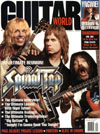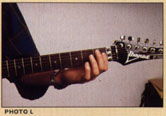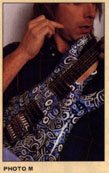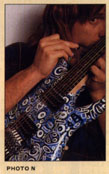 home // store // text
files
// multimedia // discography // a
to zed
// random
// links
home // store // text
files
// multimedia // discography // a
to zed
// random
// links
  Long after even the most celebrated
guitarists of this age have been forgotten, their picking hands
turned to putrid dust, Nigel Tufnel will be hailed for his manifold
contributions to rock and roll. Tufnel's brilliant two-decade
plus stint as lead guitarist with England's now-legendary Spinal
Tap has earned him an eternal place in the pantheon of rock guitar
legends. His pioneering use of such techniques as "hair
popping," his virtuosic facial contortions, and his gut-wrenching
solos on anthems like (Tonight I'm Gonna) Rock You Tonight have
delighted millions and caused thousands of guitarists to set
themselves ablaze. Long after even the most celebrated
guitarists of this age have been forgotten, their picking hands
turned to putrid dust, Nigel Tufnel will be hailed for his manifold
contributions to rock and roll. Tufnel's brilliant two-decade
plus stint as lead guitarist with England's now-legendary Spinal
Tap has earned him an eternal place in the pantheon of rock guitar
legends. His pioneering use of such techniques as "hair
popping," his virtuosic facial contortions, and his gut-wrenching
solos on anthems like (Tonight I'm Gonna) Rock You Tonight have
delighted millions and caused thousands of guitarists to set
themselves ablaze.
 Nigel was in rare form during
our all-too-brief conversation, from which the following exclusive,
private lesson was culled. Composed, candid and virtually overflowing
with phlegm and keen insight, the personable guitarist demonstrated
why, as repulsive pretenders come and go, he and Spinal Tap remain
magnificent, if malodorous, fixtures in the world of hard rock. Nigel was in rare form during
our all-too-brief conversation, from which the following exclusive,
private lesson was culled. Composed, candid and virtually overflowing
with phlegm and keen insight, the personable guitarist demonstrated
why, as repulsive pretenders come and go, he and Spinal Tap remain
magnificent, if malodorous, fixtures in the world of hard rock.
GUITAR WORLD: There are reports
that you've devised a Nigel Tufnel Theory of Music. What exactly
is this theory?
NIGEL TUFNEL: This is an exclusive
— it's not been published before. Here's the theory: People
read music, and they read notes on what they call a staff. But
if you can't read music, you can't play music that is written.
Correct? You're with me on that? Good. Now, everyone knows how
to count, don't they? Let me hear you count to five.
GW: 1, 2, 3, 4, 5.
TUFNEL: Good. Now, A is the first
letter of the alphabet. Yes? So A would be...?
GW: 1?
 TUFNEL: Yes! So on a chart, instead of
writing A in music terms-we're playing in the key of A-you go:
I for A, 2 for B, 1 for A and 3 for C. See? [Fig. 1] That's
so much simpler. TUFNEL: Yes! So on a chart, instead of
writing A in music terms-we're playing in the key of A-you go:
I for A, 2 for B, 1 for A and 3 for C. See? [Fig. 1] That's
so much simpler.
GW: What happens in the case of
a chord like G13?
TUFNEL: Okay. This is my other
theory:
If you're playing that type of music, you shouldn't be doing
it.
GW: Shouldn't be doing the Nigel
Tufnel Theory of Music?
TUFNEL: No — you shouldn't
be playing
music! Because what good are people who do that jazzy sort of
stuff? It's all too low-volume. Have you noticed that? What are
they trying to hide? What have they got to be embarrassed about?
If you're a good player, you play loud so people can hear it-that's
why we plug these things in. If you play an electric guitar —
I don't care if it's a Gibson 175 or a Charlie Christian —
turn the fuckin' thing up!
 To those people who do that
13th stuff I say, "By the time you count to 13, who cares?
The song's over anyway. So let's play some serious rock and roll."
It's all very impressive, I suppose, for some musicologists who
play jazz and all that — let them have their way. But they
must be afraid of something if they're not playing loud. To those people who do that
13th stuff I say, "By the time you count to 13, who cares?
The song's over anyway. So let's play some serious rock and roll."
It's all very impressive, I suppose, for some musicologists who
play jazz and all that — let them have their way. But they
must be afraid of something if they're not playing loud.
GW: Getting back to the Nigel Tufnel
Theory of Music: where does a B flat fit in?
TUFNEL: I've invented a little
symbol to deal with that. You know how it is in music notation-the
flat one looks like a little B [b] and the sharp one looks like
crosses with a little square in the middle [#]. Well, my system
replaces those with different-sized circles. The basis for this
is Stonehenge, which is designed around a circular theme. You'd
know this if you were ever in a helicopter or plane looking down
on Stonehenge. You haven't? [Shakes head with contemptuous
wonderment.] Let me show you how this all relates on a piece
of  paper:
Here's my music chart [Fig. 2]. We'll make it a trite,
pornographic ditty and call it Wolf's Song. Now, the chords would
be A-A-B-A-Ab. paper:
Here's my music chart [Fig. 2]. We'll make it a trite,
pornographic ditty and call it Wolf's Song. Now, the chords would
be A-A-B-A-Ab.
GW: What if it was A#?
TUFNEL: Aha! Put the circle up
here [Fig. 3]. It's easy to read-flats are lower and sharps
are higher. Now, the other thing I'm doing is taking unpleasant
folk songs and turning them into things that people can appreciate.
For instance, if an exhausted thing like Skip To My Lou is done
loudly  enough, it's no longer the strict property
of social workers specializing in geriatric care. Because old
folks will say, "Oh Cor, turn it down! It's too fuckin'
loud!" I say, play it loud and it's for everyone —
except the old folks. enough, it's no longer the strict property
of social workers specializing in geriatric care. Because old
folks will say, "Oh Cor, turn it down! It's too fuckin'
loud!" I say, play it loud and it's for everyone —
except the old folks.
GW: What new technical tricks have
you got up your greasy sleeve these days?
TUFNEL: On the new record, I do
some scatting while I play guitar. It's live — I don't know
any other way of doing it — and I don't use a talk tube
like the old boys do. It's hard to describe the maneuver, but
 let's
say you're playing in C [plays Fig. 4]. People think,
"What's that noise? Who's doing that?" But it's an
illusion — an aural illusion, a sort of parlor trick. It's
my voice, you see. It's really just my voice with the guitar. let's
say you're playing in C [plays Fig. 4]. People think,
"What's that noise? Who's doing that?" But it's an
illusion — an aural illusion, a sort of parlor trick. It's
my voice, you see. It's really just my voice with the guitar.
GW: Do you practice this technique?
TUFNEL: No, there's nothing to practice
— it's all improv. You can't practice it; you just wake
up and do it.
GW: What about intonation and rhythmic
synchronization?
TUFNEL: Well, I suppose you could practice
it, but I don't. It just developed naturally — sort of like
a rash. If you wake up in the morning and you feel, "Oh
hell, this is itching!" You lower your trousers, you look
down and you say, "Oh hell, it's a rash, isn't it?!"
You don't practice a rash, you just let it evolve and grow and
spread. This is really very much like that.
GW: Could you demonstrate the most important
elements of the idea?
TUFNEL: Sure. First, we'll show hand,
then mouth, then both together. For example, this would be the
first note [Photo A] and this would be my mouth's first
note [Photo B]. Together they are.. .[Photo C].
See? This is the hand and mouth position for the third note [Photos
D and E]. Next, the combination [Photo F]. The tough
one, of course, is the high E. The kids probably shouldn't try
to do this one without some sort of warmup. I recommend a bowl
of hot porridge or a tankard of steaming Ovaltine.
GW: How do you incorporate harmonics
into your playing?
TUFNEL: I'll demonstrate: Begin by barring
across here [Fig. 5 and Photo G]. What you've got
is sort of a minor chord [note: D minor — the tonic chord
in "the saddest of all keys]. There are easier ways
of playing this, no doubt, but that's not the point. The point
is that these [2nd and 3rd fingers: see Photo H] set up
a sympathetic vibration.
GW: That's very subtle. The fingers
actually vibrate?
 TUFNEL: [Nods, smiles condescendingly]
The fingers vibrate. Where do you think the sound goes? It
doesn't go into a hole and disappear and shout, "Help me,
doctor, I'm alone." It emanates from the guitar. So, it
goes out here [from the chord] and there's an imperceptible
vibration between these two fingers [2nd and 3rd] as it
happens. The lower you go down the neck, the more slowly they
vibrate. As you go higher [Photo I], they vibrate quite
rapidly. And funnily enough, it's an overtone — always an
overtone. TUFNEL: [Nods, smiles condescendingly]
The fingers vibrate. Where do you think the sound goes? It
doesn't go into a hole and disappear and shout, "Help me,
doctor, I'm alone." It emanates from the guitar. So, it
goes out here [from the chord] and there's an imperceptible
vibration between these two fingers [2nd and 3rd] as it
happens. The lower you go down the neck, the more slowly they
vibrate. As you go higher [Photo I], they vibrate quite
rapidly. And funnily enough, it's an overtone — always an
overtone.
GW: Any other new developments
on the fingerboard front?
TUFNEL: I've got another wonderful
trick I do. Let me draw your attention to the screws on the pickup.
[Photo J]. You'll notice that these are Phillips screws,
but the middle one [Photo K] is a regular screw —
a straight screw. Most people have two straight screws made of
titanium and a Phillips made of magnesium. Now, if you flip them
— as I do — there's a whole different interaction between
the pickups, even with single-coils. But these humbucker pickups
in particular reverberate in a very different way. It's all about
reverberation — that's what all this is about. They must
be switched for reverberation. That's for people who are into
rewiring their guitars.
GW: Do you modify your guitar in
any other way?
TUFNEL: Here's another thing. Most
people think that once you're off the frets, you go, "Lordy!
I can't go any further than the F!" Wrong. Of course you
can go further than the F — if you want it bad enough. And
I do, sometimes. But as you go diving down to the nut, it's very
easy to hurt your finger. As you can see, I've got festering
wounds — see the pus? — here from diving onto the nut
one too many times. So I've designed a great, patent-pending
device — which has yet to be installed on this guitar —
called a Nut Cozy. It's a little knit thing, made of wool, that
fits over the nut. I've also designed a Tone Cozy, a similar
thing that fits over a control knob. It droops a little bit.
Next, of course, will be a Volume Cozy. I've got a little cottage
industry going, producing them, and readers will be able to send
away for  them
soon. My Nut Cozy is great, because if you bash your finger down
here [Photo L] it's soft. them
soon. My Nut Cozy is great, because if you bash your finger down
here [Photo L] it's soft.
GW: Have you ever discovered any
valuable techniques by pure chance?
TUFNEL: Sure. A lot of the younger
kids tend to play their guitars hung way down on their knees.
They play real low because they think it looks sexy or something
— God knows what they're doing. Anyway, that sort of thing
is impractical for the older player, or the old at heart; there's
too much weight on your back. So what I do is, I use a short
strap and have the guitar sitting higher. Now this was the accident:
One  night
I was playing up here [Photo M], and my hair, by mistake,
got on the strings [Photo N]. And what I discovered, by
accident, is that this contact triggered an organic overtone.
You see, if something like metal touches the string, it's not
organic. But if it's part of your body, it's totally organic,
and it sets off a very beautiful resonance. All the great players
are aware of these things. night
I was playing up here [Photo M], and my hair, by mistake,
got on the strings [Photo N]. And what I discovered, by
accident, is that this contact triggered an organic overtone.
You see, if something like metal touches the string, it's not
organic. But if it's part of your body, it's totally organic,
and it sets off a very beautiful resonance. All the great players
are aware of these things.
GW: Does "hair touching"
actually produce a distinctive tone?
TUFNEL: Yeah. You'll hear a lot
of hair popping in my solo on Christmas With The Devil. You'll
also hear a lick in that solo based on chromatism [chromaticism].
It's beyond anything musical. If you play a scale, it's just
a scale — it doesn't link people together. Chromatism does
— because it's  from chromosomes! from chromosomes!
GW: What is your view of the of
the guitar's role in music?
TUFNEL: Well, every instrument
has its own personality. For example, I love the piano for the
depth of its feeling. But the piano is not really an instrument
— it's really taking an orchestra, shrinking the people
and putting them in a box. The guitar is actually an opera singer
with a long neck. If you're not making it sing, you might as
well go home.
GW: I'm going home.
|